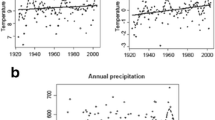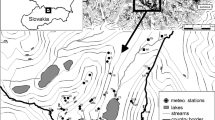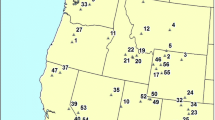Abstract
A framework to monitor mountain summit vegetation (The Global Observation Research Initiative in Alpine Environments, GLORIA) was initiated in 1997. GLORIA results should be taken within a regional context of the spatial variability of alpine tundra. Changes observed at GLORIA sites in Glacier National Park, Montana, USA are quantified within the context of the range of variability observed in alpine tundra across much of western North America. Dissimilarity is calculated and used in nonmetric multidimensional scaling for repeated measures of vascular species cover at 14 GLORIA sites with 525 nearby sites and with 436 sites in western North America. The lengths of the trajectories of the GLORIA sites in ordination space are compared to the dimensions of the space created by the larger datasets. The absolute amount of change on the GLORIA summits over 5 years is high, but the degree of change is small relative to the geographical context. The GLORIA sites are on the margin of the ordination volumes with the large datasets. The GLORIA summit vegetation appears to be specialized, arguing for the intrinsic value of early observed change in limited niche space.



Similar content being viewed by others
References
Ackerly DD, Loarie SR, Cornwell WK, Weiss SB, Hamilton H, Branciforte WK, Kraft NJB (2010) The geography of climate change: implications for conservation biogeography. Divers Distrib 16:476–487
Baker WL (1983) Alpine vegetation of Wheeler Peak, New Mexico, USA: gradient analysis, classification, and biogeography. Arctic Alpine Res 15:223–240
Bamberg SA, Major J (1968) Ecology of the vegetation and soils associated with calcareous parent material in three alpine regions of Montana. Ecol Monogr 38:127–167
Beaman JH, Andresen JW (1966) The vegetation, floristics and phytogeography of the summit of Cerro Potosi, Mexico. Am Midl Nat 75:1–33
Beder K (1967) Ecology of the alpine vegetation of Snow Creek Valley, Banff National Park, Alberta. MS thesis, University of Calgary
Billings WD (1988) Alpine vegetation. In: Barbour MG, Billings WD (eds) North American terrestrial vegetation. Cambridge University Press, Cambridge, pp 391–420
Billings WD, Bliss LC (1959) An alpine snowbank environment and its effects on vegetation, plant development, and productivity. Ecology 40:388–397
Bjork RG, Molau U (2007) Ecology of alpine snowbeds and the impact of climate change. Arct Antarct Alp Res 39:34–43
Boyce RL, Clark R, Dawson C (2005) Factors determining alpine species distribution on Goliath Peak, Front Range, Colorado, USA. Arct Antarct Alp Res 37:88–96
Braun-Blanquet J (1932) Plant sociology. McGraw-Hill, New York
Bray JR, Curtis JT (1957) An ordination of upland forest communities of southern Wisconsin. Ecol Monogr 27:325–349
Bruun HH, Moen J, Virtanen R, Grytnes J-A, Oksanen L, Angerbjorn A (2006) Effects of altitude and topography on species richness of vascular plants, bryophytes and lichens in alpine communities. J Veg Sci 17:37–46
Bryant JP (1968) Vegetation and frost activity in an alpine fellfield on the summit of Plateau Mountain, Alberta. MS thesis, University of Calgary
Callaway RM, Brooker RW, Choler P, Kikvidze Z, Lortie CJ, Michalet R, Paolini L, Pugnaire FI, Newingham B, Aschehoug ET, Armas C, Kikodze D, Cook BJ (2002) Positive interactions among alpine plants increase with stress. Nature 417:844–848
Chabot BF, Billings WD (1972) Origins and ecology of the Sierran alpine flora and vegetation. Ecol Monogr 42:163–199
Cooper DJ, Sanderson JS (1997) A montane Kobresia myosuroides fen community type in the southern Rocky Mountains of Colorado, USA. Arctic Alpine Res 29:300–303
Czekanowski J (1909) Zur differential Diagnose der Neandertalgruppe. Korrespondenzblatt der Deutschen Gesellschaft für Anthropologie 40:44–47
Damm C (2001) A phytosociological study of Glacier National Park, Montana, USA, with notes on the syntaxonomy of alpine vegetation in western North America. Dissertation, Georg-August Universitaet, Goettingen
Danby RK, Koh S, Hik DS, Price LW (2011) Four decades of plant community change in the alpine tundra of Southwest Yukon, Canada. Ambio 40:660–671
del Moral R (1979) High elevation vegetation of the Enchantment Lakes Basin, Washington. Can J Bot 57:1111–1130
Diaz HF, Eischeid JK (2007) Disappearing alpine tundra Koppen climatic type in the western United States. Geophys Res Lett 34:L18707, 1-4
Dirnbock T, Dullinger S, Grabherr G (2003) A regional impact assessment of climate and land-use change on alpine vegetation. J Biogeogr 30:401–417
Douglas GW, Ballard TM (1971) Effects of fire on alpine plant communities in the North Cascades, Washington. Ecology 52:1058–1064
Eady K (1971) Ecology of the alpine and timberline vegetation of Big White Mountain, British Columbia. Dissertation, University of British Columbia
Elmendorf SC, Henry GHR, Hollister RD et al (2012a) Plot-scale evidence of tundra vegetation change and links to recent summer warming. Nature Clim Change 2:453–457
Elmendorf SC, Henry GHR, Hollister RD et al (2012b) Global assessment of experimental climate warming on tundra vegetation: heterogeneity over space and time. Ecol Lett 15:164–175
Erschbamer B, Unterluffauer P, Winkler E, Mallaun M (2011) Changes in plant species diversity revealed by long-term monitoring on mountain summits in the Dolomites (northern Italy). Preslia 83:387–401
Evju M, Hagen D, Hofgaard A (2012) Effects of disturbance on plant regrowth along snow pack gradients in alpine habitats. Plant Ecol 213:1345–1355
Goodall DW (1978) Sample similarity and species correlation. In: Whittaker RH (ed) Ordination of plant communities. W Junk, The Hague, pp 99–149
Gottfried M, Pauli H, Futschik A et al (2012) Continent-wide response of mountain vegetation to climate change. Nat Climate Change 2:111–115
Grabherr G, Gottfried M, Pauli H (2000) GLORIA: a global observation research initiative in alpine environments. Mountain Res Dev 20:190–191
Gret-Regamey A, Walz A, Bebi P (2008) Valuing ecosystem services for sustainable landscape planning in Alpine regions. Mt Res Dev 28:156–165
Hamilton EH (1981) The alpine vegetation of Marmot Basin, Jasper National Park, Alberta and the impact of ski activities upon it. MS thesis, University of Alberta
Harris SA (2007) Biodiversity of the alpine vascular flora of the NW North American Cordillera: the evidence from phyto-geography. Erdkunde 61:344–357
Holzer K, Fagre D (2004) The Glacier National Park GLORIA project: A new US target region for alpine plant monitoring installed in the northern Rocky Mountains, Montana. EOS Trans Am Geophys U 85(47), Fall Meet Suppl, Abstract U53A-0712
Huelber K, Gottfried M, Pauli H, Reiter K, Winkler M, Grabherr G (2006) Phenological responses of snowbed species to snow removal dates in the Central Alps: implications for climate warming. Arct Antarct Alp Res 38:99–103
Ingersoll CA (1991) Plant reproductive ecology and community structure along a subalpine snowmelt gradient. Dissertation, Oregon State University
Inouye DW (2008) Effects of climate change on phenology, frost damage, and floral abundance of montane wildflowers. Ecology 89:353–362
Johnson KL (1970) Alpine vegetation and soils of Mesa Seco Plateau, San Juan Mountains, Colorado. Dissertation, University of Illinois
Johnson PL, Billings WD (1962) The alpine vegetation of the Beartooth Plateau in relation to cryopedogenic processes and patterns. Ecol Monogr 32:105–135
Johnson CG Jr (2004) Alpine and subalpine vegetation of the Wallowa, Seven Devils and Blue Mountains. USDA Forest Service R6-NR-ECOL-TP-03-04
Kammer PM, Schöb C, Choler P (2007) Increasing species richness on mountain summits: upward migration due to anthropogenic climate change or re-colonisation? J Veg Sci 18:301–306
Kapfer J, Birks HJB, Felde VA, Klanderud K, Martinessen T, Ross LC, Schei FH, Virtanen R, Grytnes JA (2013) Long-term vegetation stability in northern Europe as assessed by changes in species co-occurrences. Plant Ecol Diver 6:289–302
Kikvidze Z, Pugnaire FI, Brooker RW, Choler P, Lortie CJ, Michalet R, Callaway RM (2005) Linking patterns and processes in alpine plant communities: a global study. Ecology 86:1395–1400
Komarkova V (1979) Alpine vegetation of the Indian Peaks Area. J Cramer, Vaduz
Körner C (2002) Mountain biodiversity, its causes and function: an overview. In: Körner C (ed) Mountain biodiversity. CRC Press, Boca Raton, pp 3–20
Kuchar P (1975) Alpine tundra communities and Dryas octopetala spp Hookeriana in the Bald Hills, Jasper National Park. Dissertation, University of Alberta
Kudo G, Kimura M, Kasagi T, Kawai Y, Hirai AS (2010) Habitat specific responses of alpine plants to climatic amelioration: comparison of fellfield to snowbed communities. Arct Antarct Alp Res 42:438–448
Lenoir J, Gegout JC, Marquet PA, de Ruffray P, Brisse H (2008) A significant upward shift in plant species optimum elevation during the 20th century. Science 320:1768–1771
Lesica P, McCune B (2004) Decline of arctic-alpine plants at the southern margin of their range following a decade of climatic warming. J Veg Sci 15:679–690
Lesica P, Steele BM (1996) A method for monitoring long-term population trends: an example using arctic-alpine plants. Ecol Appl 6:879–887
Litaor MI, Williams M, and Seastedt TR (2008) Topographic controls on snow distribution, soil moisture, and species diversity of herbaceous alpine vegetation, Niwot Ridge, Colorado. J Geophys Res – Biogeosci 113:G2, G02008
Loffler J, Pape R (2008) Diversity patterns in relation to the environment in alpine tundra ecosystems of northern Norway. Arct Antarct Alp Res 40:373–381
Loope LL (1970) Subalpine and alpine vegetation of northeastern Nevada. Dissertation, Duke University
MacArthur RH, Wilson EO (1967) The theory of island biogeography. Princeton University Press, Princeton
Malanson GP, Trabaud L (1987) Ordination analysis of components of resilience of Quercus coccifera garrigue. Ecology 68:463–473
Malanson GP, Butler DR, Fagre DB (2007) Alpine ecosystem dynamics and change: a view from the heights. In: Prato T, Fagre D (eds) Sustaining Rocky Mountain landscapes: science, policy and management of the Crown of the Continent Ecosystem. Resources for the Future Press, Washington, pp 85–101
Malanson GP, Rose JP, Schroeder PJ, Fagre DB (2011) Contexts for change in alpine tundra. Phys Geogr 32:97–113
Malanson GP, Bengtson LE, Fagre DB (2012) Geomorphic determinants of species composition of alpine tundra, Glacier National Park, USA. Arct Antarct Alp Res 44:197–209
McCune B, Grace JB (2002) Analysis of ecological communities. MjM Software Design, Gleneden Beach
McCune B, Mefford MJ (2011) PC-ORD multivariate analysis of community data version 6. MjM Software Design, Gleneden Beach
Millar C, Fagre D (2007) Monitoring alpine plants for climate change; the North American GLORIA project. Mountain Views 1(1):12–14
Mooney HA (1973) Plant communities and vegetation. In: Lloyd RM, Mitchell RS (eds) A flora of the White Mountains. University of California, Berkeley, California and Nevada, pp 7–17
Mortimer PR (1978) The alpine vascular flora and vegetation of Prospect Mountain, Front Range, Rocky Mountains, Alberta. MS thesis, University of Alberta
Moseley RK (1985) Synecological relationships of alpine spike-fescue grasslands in east-central Idaho. MS thesis, University of Idaho
Moseley RK (1993) Alpine flora of the upper Little Wood River, Pioneer Mountains, Sawtooth National Forest. Sawtooth National Forest and Idaho Department of Fish and Game, Boise
Nagy L, Grabherr G (2009) The biology of alpine habitats. Oxford University Press, New York
Ostler WK, Harper KT, McKnight KB, Anderson DC (1982) The effects of increasing snowpack on a subalpine meadow in the Uinta Mountains, Utah, USA. Arctic Alpine Res 14:203–214
Otypkova Z, Chytry M (2006) Effects of plot size on the ordination of vegetation samples. J Veg Sci 17:465–472
Pauli H, Gottfried M, Reiter K, Klettner C, Grabherr G (2007) Signals of range expansions and contractions of vascular plants in the high Alps: observations (1994-2004) at the GLORIA master site Schrankogel, Tyrol, Austria. Glob Change Biol 13:147–156
Pauli H, Gottfried M, Dullinger S et al (2012) Recent plant diversity changes on Europe’s mountain summits. Science 336:353–355
Pemble RH (1970) Alpine vegetation in the Sierra Nevada of California as lithosequences and in relation to local site factors. Dissertation, University of California, Davis
Phillips VD III (1982) Responses by alpine plants and soils to microtopography within sorted polygons. Dissertation, University of Colorado, Boulder
Randin CF, Engler R, Normand S, Zappa M, Zimmermann NE, Pearman PB, Vittoz P, Thuiller W, Guisan A (2009a) Climate change and plant distribution: local models predict high-elevation persistence. Glob Change Biol 15:1557–1569
Randin CF, Vuissoz G, Liston GE, Vittoz P, Guisan A (2009b) Introduction of snow and geomorphic disturbance variables into predictive models of alpine plant distribution in the western Alps. Arct Antarct Alp Res 41:347–361
Robbins JA, Matthews JA (2010) Regional variation in successional trajectories and rates of vegetation change on glacier forelands in south-central Norway. Arct Antarct Alp Res 42:351–361
Rose JP, Malanson GP (2012) Microtopographic heterogeneity constrains alpine plant diversity, Glacier National Park, MT. Plant Ecol 213:955–965
Ross LC, Woodin SJ, Hester A, Thompson DBA, Birks HJB (2010) How important is plot relocation accuracy when interpreting re-visitation studies of vegetation change? Plant Ecol Divers 3:1–8
Ross LC, Woodin SJ, Hester A, Thompson DBA, Birks HJB (2012) Biotic homogenization of upland vegetation: patterns and drivers at multiple scales over five decades. J Veg Sci 23:755–770
Sandvik S, Heegaard E, Elven R, Vandvik V (2004) Responses of alpine snowbed vegetation to long-term experimental warming. Ecoscience 11:150–159
Scherrer D, Körner C (2011) Topographically controlled thermal-habitat differentiation buffers alpine plant diversity against climate change. J Biogeogr 38:406–416
Smith JG, Sconiers W, Spasojevic MJ, Ashton IW, Suding KN (2012) Phenological changes in alpine plants in response to increased snowpack, temperature, and nitrogen. Arct Antarct Alp Res 44:135–142
Sorensen T (1948) A method of establishing groups of equal amplitude in plant sociology based on similarity of species content. Biologiske Skrifter/Kongelige Danske Videnskabernes 5(4):1–34
St Clair LL (1984) Lichen distribution along an alpine tundra ridge in the high Uintas of northeastern Utah, USA Dissertation, University of Colorado
Stanton ML, Rejmanek M, Galen C (1994) Changes in vegetation and soil fertility along a predictable snowment gradient in the Mosquito Range, Colorado, USA. Arctic Alpine Res 26:364–374
Stoeckli V, Wipf S, Nilsson C, Rixen C (2011) Using historical plant surveys to track biodiversity on mountain summits. Plant Ecol Divers 4:415–425
Taylor DW (1976) Ecology of the timberline vegetation at Carson Pass, Alpine County, California. Dissertation, University of California, Davis
Trottier GC (1972) Ecology of the alpine vegetation of Highwood Pass, Alberta. MS thesis, University of Calgary
Urbanczyk SM (1993) Alpine plant communities, Sheep Mountain, Lemhi County, Idaho. MS thesis, University of Idaho
Vonlanthen CM, Buhler A, Veit H, Eugster W (2006) Alpine plant communities: as statistical assessment of their relation to microclimatological, pedological, geomorphological, and other factors. Phys Geogr 27:137–154
Walther G-R, Beibner S, Burga CA (2005) Trends in the upward shift of alpine plants. J Veg Sci 16:541–548
Willard BE (1979) Plant sociology of alpine tundra, Trail Ridge, Rocky Mountain National Park Colorado. Colo School Mines Q 74(4):1–119
Wipf S, Stoeckli V, Bebi P (2009) Winter climate change in alpine tundra: responses to changes in snow depth and snowmelt timing. Climatic Change 94:105–121
Acknowledgments
This research was supported by a seed grant from the University of Iowa Center for Global and Regional Environmental Research to GPM, by a US Geological Survey Park-Oriented Biological Support grant to DBF, and by NSF award 1121305. Any use of trade, product, or firm names is for descriptive purposes only and does not imply endorsement by the U.S. Government. This is a contribution from the Mountain GeoDynamics Research Group.
Author information
Authors and Affiliations
Corresponding author
Rights and permissions
About this article
Cite this article
Malanson, G.P., Fagre, D.B. Spatial contexts for temporal variability in alpine vegetation under ongoing climate change. Plant Ecol 214, 1309–1319 (2013). https://doi.org/10.1007/s11258-013-0253-3
Received:
Accepted:
Published:
Issue Date:
DOI: https://doi.org/10.1007/s11258-013-0253-3




